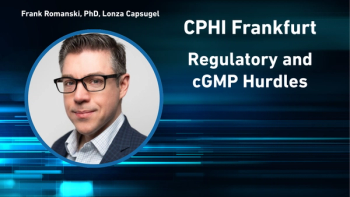
- Pharmaceutical Technology-05-02-2020
- Volume 44
- Issue 5
Can EMA’s Regulatory Science Strategy Meet Medicine’s Major Challenges?
EMA’s strategy for regulatory science has divided opinion amongst various industry bodies.
Editor’s Note: This article was published in Pharmaceutical Technology Europe’s May 2020 print issue.
The European Medicines Agency (EMA) published, at the end of March 2020, the final version of a report on its strategy for regulatory science, which it sees as the basis for meeting the major challenges in medicine during the next five years (1). Three years of the report’s preparation involved several rounds of consultation and two workshops with representatives of stakeholders.
But, unfortunately, the document was issued at a time when the coronavirus outbreak (COVID-19) had not yet shown itself to be causing the biggest public health crisis in Europe for 100 years. As a result, the report, which covers both human and veterinary medicines, devotes relatively limited space to ways of using regulatory science to deal with pandemics such as COVID-19, particularly the emergency development and mass-scale manufacture of vaccines.
Instead, to deal with the outbreak, EMA has implemented its 2018 Health Threat Plan by setting up a COVID-19 EMA Emergency Task Force (ETF), which will assist in the development, authorization, and safety monitoring of therapeutics and vaccines to deal with the pandemic (2). The agency has also been internationally active by co-chairing virtual meetings of the International Coalition of Medicines Regulatory Authorities (ICMRA) on collaboration between regulators on the development of vaccines and the authorization of repurposed drugs for COVID treatments (3).
Analysis of responses
EMA also published, with the regulatory science report, an analysis of stakeholder responses during the six-month public consultation to mid-2019 on the last draft of the document (4). The analysis confirmed that prior to COVID-19, pandemics and similar emergencies were not only being given relatively low importance by regulators but also by many stakeholder groups as well, particularly the pharma industry (4).
The study on responses also showed that among some stakeholders, even among national regulators, there is scepticism about EMA as the European Union’s central agency for pan-European approval of drug taking on extended roles beyond issues of medicines authorization. This opposition may become significant if EMA’s responsibilities are re-examined post-COVID-19.
EMA’s consultation analysis, in which the 154 respondents, mostly in human medicines, were split into five clusters of patient/consumer organizations, healthcare professionals, research, public bodies, and the pharma industry, showed a relatively low recognition of the importance of issues linked to emergencies (4). These issues included health threat and preparedness planning, vaccines development and production, and repurposing of existing drugs. Of the regulatory science report’s total of 30 core recommendations, these issues were all ranked among the lowest five in importance (4).
When respondents were asked to select one of their top three recommendations as delivering “the most significant change in the regulatory system over the next five years,” one on developing a framework for repurposing drugs and another on health threat and preparedness plans received no support (4). A proposed initiative on “innovative approaches to the development and post-authorization monitoring of vaccines” was backed by only four respondents (4).
Emerging challenges
The regulatory science report highlighted the challenge of emerging technologies, such as new vaccine technologies and their manufacturing processes. But the main technologies pinpointed by the report were big data, precision medicines, clinical trial design, and even synthetic biology. For regulators, a big dilemma is the acquisition of knowledge about new sciences.
On plans for the emergency development of vaccines and their large-scale manufacture, EMA suggested working with the EU’s regulatory partners outside Europe to harmonize the regulatory framework for vaccine clinical trials. Dedicated regulatory science advice and evaluation procedures have already been set up in the EU to support the fast development and oversight of new medicines, ranging from pandemic flu to any currently unidentified pathogen or ‘disease X’, the report said (1). The EU has research programmes to promote large-scale clinical research into infectious diseases and to design manufacturing processes to ensure rapid delivery of vaccines and antibodies.
According to the report, experiences with the Ebola and Zika viruses, as well as the COVID-19 coronavirus, have demonstrated the importance of communications within the EU regulatory network and among stakeholders. To help preparedness, scientific evidence should be defined prior to outbreaks so that resources needed to combat the disease can be identified and ring-fenced (1). Additionally, the report suggested the creation of a platform for the monitoring of vaccine safety and effectiveness in the post-approval phase. It also recommended fostering the development of improved delivery systems based on novel technologies (1).
Report recommendations
The primary goal of the regulatory science strategy was to ensure that regulation can support the development of new medicines and innovative techniques, including manufacturing processes. This goal required even closer collaboration with academics and research centres to ensure an ongoing dialogue between regulators and developers at all R&D stages (1).
New vaccines are among products requiring new manufacturing processes because of the need for rapid scale-up and fast production to bring them to patients as quickly as possible. These processes may seem to be contrary to the trend towards the development of complex manufacturing systems for the production of personalized advanced therapy medicinal products (ATMPs), which could be made at the point of care. However, there are also similarities. Novel vaccine production processes, particularly those requiring large quantities in response to pandemics, such as COVID-19, need a lot of flexibility and possibly different standards of good manufacturing practice (GMP).
The report recommended that the creation of novel manufacturing technologies should be enhanced by regulators being trained in their assessment. This would help the identification of potential production problems while strengthening the early interaction between regulators, developers, and other stakeholders on the regulatory requirements for innovative manufacturing technologies.
The introduction of new manufacturing processes will probably need, for regulatory purposes, the involvement of EMA’s four-year-old Priority Medicines (PRIME) system under which early scientific advice to developers of medicines addressing unmet needs is provided by the agency’s experts.
In the regulatory science report, EMA conceded that PRIME is resource intensive, while its purpose is not properly understood by some stakeholders. EMA recommended improved external communication about the scheme and proposed that measures should be taken to shorten PRIME review times. Furthermore, EMA suggested that the system should be reviewed in five years.
The agency also acknowledged that the involvement of Health Technology Assessment organizations (HTAs) in PRIME is crucial so that the scientific advice takes their requirements into account. In their responses during the consultation, HTAs wanted closer alignment with regulators in areas such as pre-approval scientific advice. Whereas, pharma industry respondents were hostile to HTAs being involved in decision making because it complicates and politicises the licensing process, according to the analysis (4).
Divided opinion
This division of opinion was evident in a range of responses to recommendations in the regulatory science report; although on the whole, the recommendations were welcomed by respondents across the five clusters. Ironically the pharma industry and the research sector, whose representatives made up the majority of respondents, were the most supportive of the research science strategy. Among the organizations that tended to be the most critical and sceptical were public bodies.
Some HTAs were against EMA extending its role in areas, such as biosimilars uptake and drug shortages, according to the analysis of the responses (4). In addition to medicines authorizations, the agency should concentrate on information sharing and facilitating co-operation between stakeholders, some HTAs claimed. Payers were concerned that EMA’s expanded role in bringing new medicines to market, such as through PRIME, made it a ‘co-developer’, while it should be restricting itself to the demonstration of clinical benefits and assuring a positive benefit/risk balance. Among EU regulators, national competent authorities (NCAs) for medicines licensing had doubts about how the regulatory science strategy would be turned into action and how NCAs would be involved in its implementation.
Overall, regulators and institutions questioned the sustainability of the EU’s current regulatory system in areas, such as updating guidance documents and the effective functioning of working parties and committees (4). No doubt some of these differences with stakeholders will be resolved by the imminent finalization of the EU’s regulatory network strategy to 2025 and the publication of the European Commission’s own strategy for pharmaceuticals.
References
1. EMA, “
2. EMA, “
3. ICMRA, “ICMRA meeting: COVID-2019 Real-World Evidence and Observational Studies,” icmra.info (6 April 2020).
4. EMA, “
Article Details
Pharmaceutical Technology Europe
Vol. 32, No. 5
May 2020
Pages: 6–8
Citation
When referring to this article, please cite it as S. Milmo, “Can EMA’s Regulatory Science Strategy Meet Medicine’s Major Challenges?” Pharmaceutical Technology Europe 32 (5) 2020.
Articles in this issue
over 5 years ago
Modern Drug Manufacturing Key to COVID-19 Responseover 5 years ago
How Fast Is Too Fast?over 5 years ago
Starting a Career in the Bio/Pharmaceutical Industryover 5 years ago
Can We Teach an Old Drug New Tricks?over 5 years ago
Good Manufacturing Practices: Aseptic and Sterile Processingover 5 years ago
Small-Volume Conversion Kit for Bathless Dissolution Testersover 5 years ago
Inline High Shear Mixersover 5 years ago
Pre-Packed Columnsover 5 years ago
Laser-Marked Smart ContainersNewsletter
Get the essential updates shaping the future of pharma manufacturing and compliance—subscribe today to Pharmaceutical Technology and never miss a breakthrough.




